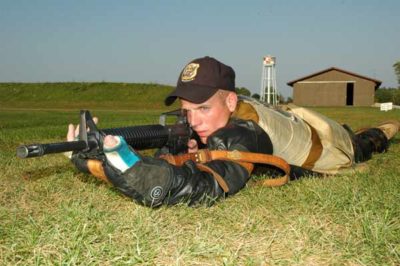
I was talking to a veteran police officer the other day, a tough street cop in one of the largest police departments in the country.
Over the course of his 26-year career, this officer had gotten himself into no less than three shootings, all three of which resulted in the death of a bad guy. The interesting part wasn’t so much the shootings, but the position used in each shooting that is definitely cause for further examination: one shooting was from a seated position inside the officer’s cruiser, another, on the officer’s side while lying on the ground crouched behind his tire; the last, standing in a proper weaver stance.
What’s interesting about this scenario is that only one out of three shooting positions was from a conventional, upright stance. This should definitely be a concern for the concealed carry enthusiast who has it in his or her head that when a threat presents itself, they are going to stand up, break into that perfect weaver or isosceles stance, and fire at the bad guy just as if they are at the range.
It’s no secret that the vast majority of gun owners train with range safety rules in mind. In and of itself, there is nothing wrong with range safety, but you need to consider that when your time comes to draw that weapon in self defense, you most likely won’t be doing so from behind a bright red line, or with convenient partitions on either side of you or even range commands coming from the speakers. You’ll shoot from wherever you happen to be, whether that means sitting down to dinner in a restaurant, over your sleeping spouse in bed, or from the driver’s seat of your car. All of these positions aren’t exactly easily practiced at most ranges, so you’ll need to think outside the box in doing so.
How To Defend Yourself And Your Family Against The New Breed Of Lowlife Criminal Scum
Sure, the great bulk of your training can be accomplished using conventional shooting positions; after all, that’s how you learn the fundamentals of breathing control, sight picture, sight alignment, and trigger squeeze. Once you have become a master of the basics, however, consider shooting from some new positions. Keep in mind: You may need to switch shooting locations in order to do some of these, since most ranges will frown upon them. Find a piece of Bureau of Land Management (BLM) land to practice on, or some similar locale. Try these:
1. Prone: An oft-taught position in the military, prone shooting is accomplished by lying upon your stomach and facing the target, arms extended, weapon in hand. Prone shooting is inherently safe and is often used to teach neophytes the basics of rifle shooting because the likelihood that the new shooter can flag people beside him with his weapon is fairly low. Still, prone shooting works great for pistols as well – your elbows touch the ground, giving you good support and making your shooting more accurate than it would be when standing upright. Finally, you present a low silhouette and very little target area to a threat while in the prone position.
2. Supine: Lying on your back and shooting through your open knees isn’t a position we would choose as the best for marksmanship, but sometimes, supine shooting is a necessity. Supine shooting is one of those positions you might just happen to fall into when reacting to a threat; you might dive back out of your restaurant booth or push out of the driver’s seat of your car, landing on your back. It’s not the best position, but it does happen and is a position that’s easily practiced. Lie on your back, knees spread apart and head elevated as if you were doing a crunch. The pistol will not usually extend past your knees, which means you need to take extra care to not shoot your kneecaps off when tracking a target. Practice at half speed at first.
3. On your side: Usually accomplished behind a barricade of some sort, lying on your side can present a very small target since normally only your gun hand and a piece of your face is exposed, with the rest covered by a barricade. Again, lying on your side happens to be a position you might fall into when reacting to a threat; it’s not a position you would normally choose. Practice shooting with both hands and lying on both sides to become proficient at it. Some pointers to keep in mind are keeping the pistol sufficiently far off the ground to prevent the slide from snagging anything, and being careful of not placing the ejection port too close to the ground to prevent jamming or stovepipes.
4. From a car: There is no reason why you can’t practice shooting while belted into your car, from both the driver window and passenger window. On some pieces of BLM land, this is really easy; just set up your target and fire away. Realize that in a real gun battle, you might have to shoot through a door or window as well, but for now, using the open windows, just shoot – safely, of course. Hearing protection is paramount when practicing this type of shooting; you most likely won’t have it in real life, but for now, wear it and even double up.
By practicing shooting from unconventional positions, you could inadvertently save your own life or the life of a loved one. Not every shooting happens in a clear, well-lit range environment – as a matter of fact, the vast majority of shootings do not happen in such places at all. How you practice shooting could spell the difference between success – and defeat.











